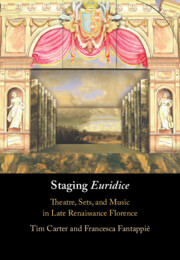Book contents
- Staging Euridice
- Staging Euridice
- Copyright page
- Contents
- Illustrations
- Tables
- Preface
- Sources, Transcriptions, and Translations
- Money, Accounts, Measurements, Dates, and Time
- Abbreviations
- 1 Euridice in Context
- 2 Staging and Sets
- 3 Euridice in Performance
- 4 Conclusions and Consequences
- Appendix I: Documents
- Works Cited
- Index
4 - Conclusions and Consequences
Published online by Cambridge University Press: 11 November 2021
- Staging Euridice
- Staging Euridice
- Copyright page
- Contents
- Illustrations
- Tables
- Preface
- Sources, Transcriptions, and Translations
- Money, Accounts, Measurements, Dates, and Time
- Abbreviations
- 1 Euridice in Context
- 2 Staging and Sets
- 3 Euridice in Performance
- 4 Conclusions and Consequences
- Appendix I: Documents
- Works Cited
- Index
Summary
Cigoli’s sets for Euridice continued to be used in the Sala delle Commedie in the Palazzo Pitti, although by 1608 they were being replaced by a more complex stage and scenery intended for different kinds of entertainments (often involving dancing) that were better suited to princely tastes. Opera briefly gained a stronger foothold in different spaces, often in patrician residences (as with Marco da Gagliano’s new setting of Rinuccini’s first libretto, Dafne, performed in 1611 in the palace occupied by Don Giovanni de’ Medici). However, the genre’s history was patchy until the establishment of the first “public” opera houses in Venice from 1637 on. But this, in turn, raises questions about how “early” operas might best be staged today. So-called Historically Informed Performance – using the resources and techniques to create music as it might have sounded in the past – is now well established in musical circles, but less so in their theatrical equivalent. The search for relevance on the part of modern directors also makes opera production a fraught site of contest between the sources and what to do with them. Is any historical reconstruction of Euridice a mere archeological curiosity, or an opportunity to give it new life?
Keywords
- Type
- Chapter
- Information
- Staging 'Euridice'Theatre, Sets, and Music in Late Renaissance Florence, pp. 198 - 216Publisher: Cambridge University PressPrint publication year: 2021



